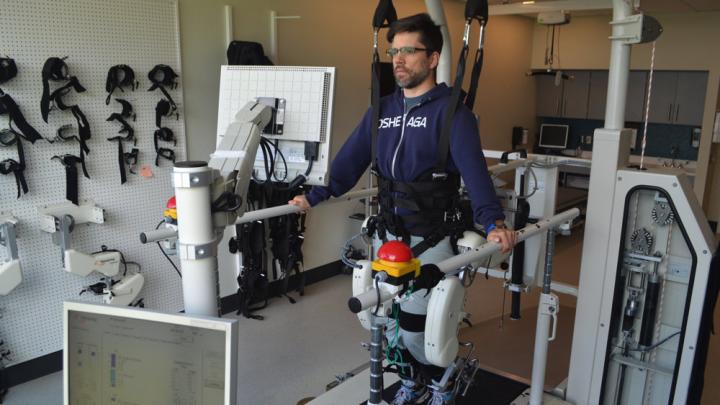Harvard researchers have designed robots to address various medical applications, from helping hearts pump blood to fighting cancer. Now, they’re adding a new accomplishment to their list: improving mobility. Two research teams have tackled this challenge by designing a special type of robot called an exosuit: a soft, flexible robotic device that people can wear like another layer of clothing.
Loeb associate professor of engineering and applied sciences Conor Walsh previously designed exosuits to improve soldiers’ endurance. He compared the action of his robot to someone pushing another person on a swing: instead of physically moving the swing back and forth, a light push at the right time is all that’s needed. His robot, strapped around the hips, provided a burst of power to the wearer’s legs by pushing at a precise moment—and that reduced the amount of energy needed to walk by 23 percent, compared to unaided walking.
This time, Walsh and his team looked at jogging instead of walking. They also compared two different types of exosuits. The first imitated nature, providing the right pushes to mimic known patterns of human movement. The second tried instead to match a simulation from a different study, which proposed a new type of optimally assisted movement that does not focus on natural joint movement. Surprisingly, they found that the second exosuit was better than the first. The nature-inspired exosuit reduced the metabolic cost of jogging by 5.4 percent compared to jogging without it, but the simulation-inspired exosuit reduced it even more: 9.1 percent.
Meanwhile, a research group with connections to the school of engineering and applied sciences and led by Iahn Cajigas, M.D '09, now at the University of Miami’s Miller School of Medicine, has also taken an interest in exosuits. One of the researchers, associate professor of physical medicine and rehabilitation Paolo Bonato, explains that the team has used exosuits to help restore normal walking patterns in people with physical disabilities. The robots worked well for 70 percent of their patients, but the remaining 30 percent still had problems. So the researchers strapped exosuits to 15 people with normal gaits and studied them while walking, then while walking with the robots providing pushes (as in Walsh’s experiment), and finally while walking normally again. When the robots started their perturbations, Bonato explains, the subjects’ brains started adapting to the change. In much the same way that humans shift gaits to walk on land and in water, the subjects intuitively walked differently when the robot was perturbing them. (This happened, however, only when step length was changed—not step height—because step length is crucial for feeling stable when walking.)
The next step for both teams is to use the technology to help people reestablish normal walking patterns. Bonato’s team is working with those patients who didn’t benefit from the original design. Walsh’s team is focused on making their exosuit more lightweight, and on engineering a robot that can understand someone’s walking pattern and adjust itself to provide the most effective assistance.
Their work has led to new considerations in exosuit development. Walsh’s research shows that engineers don’t need to look to biology for all the answers; they can design new, more efficient ways of moving, that actually improve on nature. Cajigas and Bonato’s work shows that machines, by perturbing natural walking patterns, can help retrain people to walk. The ultimate goal, both groups of researchers agree, is developing technology to improve people’s mobility. And they appear to be succeeding.








